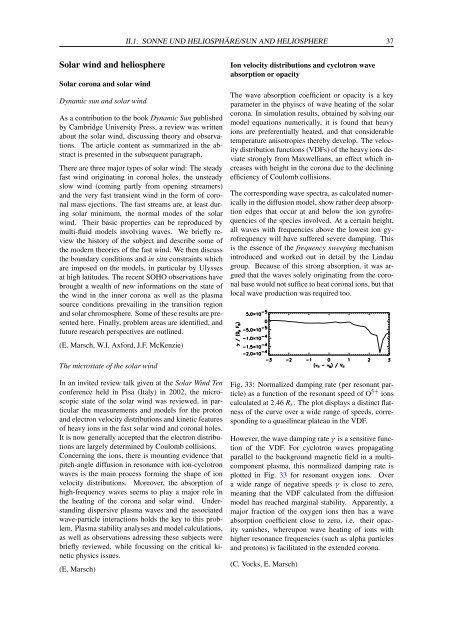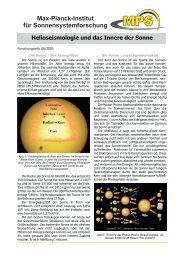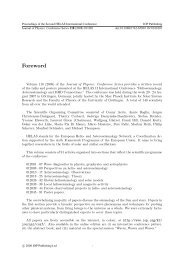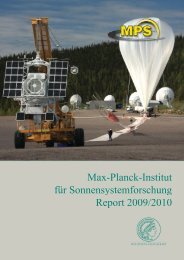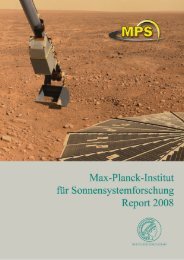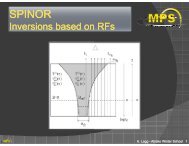MPAe T1ex127-.45ex51275atigkeitsbericht 2002/2003 - Max-Planck ...
MPAe T1ex127-.45ex51275atigkeitsbericht 2002/2003 - Max-Planck ...
MPAe T1ex127-.45ex51275atigkeitsbericht 2002/2003 - Max-Planck ...
You also want an ePaper? Increase the reach of your titles
YUMPU automatically turns print PDFs into web optimized ePapers that Google loves.
Solar wind and heliosphere<br />
Solar corona and solar wind<br />
Dynamic sun and solar wind<br />
II.1. SONNE UND HELIOSPHÄRE/SUN AND HELIOSPHERE 37<br />
As a contribution to the book Dynamic Sun published<br />
by Cambridge University Press, a review was written<br />
about the solar wind, discussing theory and observations.<br />
The article content as summarized in the abstract<br />
is presented in the subsequent paragraph.<br />
There are three major types of solar wind: The steady<br />
fast wind originating in coronal holes, the unsteady<br />
slow wind (coming partly from opening streamers)<br />
and the very fast transient wind in the form of coronal<br />
mass ejections. The fast streams are, at least during<br />
solar minimum, the normal modes of the solar<br />
wind. Their basic properties can be reproduced by<br />
multi-fluid models involving waves. We briefly review<br />
the history of the subject and describe some of<br />
the modern theories of the fast wind. We then discuss<br />
the boundary conditions and in situ constraints which<br />
are imposed on the models, in particular by Ulysses<br />
at high latitudes. The recent SOHO observations have<br />
brought a wealth of new informations on the state of<br />
the wind in the inner corona as well as the plasma<br />
source conditions prevailing in the transition region<br />
and solar chromosphere. Some of these results are presented<br />
here. Finally, problem areas are identified, and<br />
future research perspectives are outlined.<br />
(E. Marsch, W.I. Axford, J.F. McKenzie)<br />
The microstate of the solar wind<br />
In an invited review talk given at the Solar Wind Ten<br />
conference held in Pisa (Italy) in <strong>2002</strong>, the microscopic<br />
state of the solar wind was reviewed, in particular<br />
the measurements and models for the proton<br />
and electron velocity distributions and kinetic features<br />
of heavy ions in the fast solar wind and coronal holes.<br />
It is now generally accepted that the electron distributions<br />
are largely determined by Coulomb collisions.<br />
Concerning the ions, there is mounting evidence that<br />
pitch-angle diffusion in resonance with ion-cyclotron<br />
waves is the main process forming the shape of ion<br />
velocity distributions. Moreover, the absorption of<br />
high-frequency waves seems to play a major role in<br />
the heating of the corona and solar wind. Understanding<br />
dispersive plasma waves and the associated<br />
wave-particle interactions holds the key to this problem.<br />
Plasma stability analyses and model calculations,<br />
as well as observations adressing these subjects were<br />
briefly reviewed, while focussing on the critical kinetic<br />
physics issues.<br />
(E. Marsch)<br />
Ion velocity distributions and cyclotron wave<br />
absorption or opacity<br />
The wave absorption coefficient or opacity is a key<br />
parameter in the phyiscs of wave heating of the solar<br />
corona. In simulation results, obtained by solving our<br />
model equations numerically, it is found that heavy<br />
ions are preferentially heated, and that considerable<br />
temperature anisotropies thereby develop. The velocity<br />
distribution functions (VDFs) of the heavy ions deviate<br />
strongly from <strong>Max</strong>wellians, an effect which increases<br />
with height in the corona due to the declining<br />
efficiency of Coulomb collisions.<br />
The corresponding wave spectra, as calculated numerically<br />
in the diffusion model, show rather deep absorption<br />
edges that occur at and below the ion gyrofrequencies<br />
of the species involved. At a certain height,<br />
all waves with frequencies above the lowest ion gyrofrequency<br />
will have suffered severe damping. This<br />
is the essence of the frequency sweeping mechanism<br />
introduced and worked out in detail by the Lindau<br />
group. Because of this strong absorption, it was argued<br />
that the waves solely originating from the coronal<br />
base would not suffice to heat coronal ions, but that<br />
local wave production was required too.<br />
Fig. 33: Normalized damping rate (per resonant particle)<br />
as a function of the resonant speed of O 5+ ions<br />
calculated at 2.46 Rs. The plot displays a distinct flatness<br />
of the curve over a wide range of speeds, corresponding<br />
to a quasilinear plateau in the VDF.<br />
However, the wave damping rate γ is a sensitive function<br />
of the VDF. For cyclotron waves propagating<br />
parallel to the background magnetic field in a multicomponent<br />
plasma, this normalized damping rate is<br />
plotted in Fig. 33 for resonant oxygen ions. Over<br />
a wide range of negative speeds γ is close to zero,<br />
meaning that the VDF calculated from the diffusion<br />
model has reached marginal stability. Apparently, a<br />
major fraction of the oxygen ions then has a wave<br />
absorption coefficient close to zero, i.e. their opacity<br />
vanishes, whereupon wave heating of ions with<br />
higher resonance frequencies (such as alpha particles<br />
and protons) is facilitated in the extended corona.<br />
(C. Vocks, E. Marsch)


